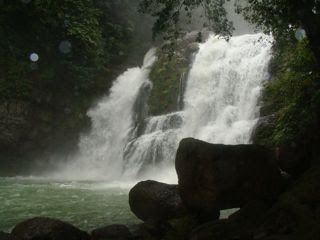This route is relatively new, and there have been reports of road closures after heavy rains. When driving in Costa Rica, always try to anticipate a city in the direction of travel so that you’re prepared for junctions. Drivers are generally courteous, but may not yield to faster moving traffic by staying to the right. It’s common for the right lane to merge left, and you do not have any rights when this happens (Ceda El Paso). Merge early and carefully.
Take CA (Central America) 1 to the west about 4km. This requires that you leave the airport, exit to the right, then merge with westward traffic from the left.
Exit at Radial El Coyol. Cross over highway on overpass. Take second exit at roundabout to continue on main road. This will go through several other roundabouts, and will eventually give you an option of Costa Rica Highway 27.
CR 27 is a toll road and will cost about 1500 Colones total, at three toll booths. There are very few navigational choices to make, but you want to go in the direction of Orotina, Caldera, and Puntarenas. The road is frequently being repaired, so look out for slower traffic and temporary lane adjustments.
About 6km beyond Orotina, and immediately after the third toll booth, exit right following the signs to Jaco. You’ll be on this road for 90 minutes. The roadside restaurants are cheap and convenient. Continue past Jaco to Parrita, Quepos, and Dominical.
At Dominical, you’ll pass over a large concrete bridge. Continue south for about 1.5km, past the Caldwell Banker office, the Resaurant Carreta, and the Restaurant Roca Verde. Our driveway is about 200 yds beyond Roca Verde on the right. It is marked by two reflective posts on either side of the driveway, and a red/white/blue utility pole that is visible during the day. You should be able to see the houses beyond the driveway. The driveway is steep and a sharp right hand turn, so put on your blinkers and take your time. At the bottom of the hill, turn into the driveway to the left or have the security guard open it for you. Each home has off-road parking so that no one is blocked in. This link should give you a good route using Google Maps.
This route is longer, but it travels over a high mountain pass which allows you to see the ecological diversity of the country. You’re above 9,000 feet for about an hour. Not for the faint of heart; there is truck and bus traffic which can be intimidating, along with slow vehicles and few safe places to pass. Take your time and get there safely. If it's foggy or rainy, really slow down!
Take CA 1 towards San Jose for about 12.5km.
Take the off ramp to CR 39, “Escazu” and “Hatillo”.
Stay on CR 39 for 10.5km. At the fifth traffic circle in Zapote, take highway 215 on right.
Travel in the direction of Cartago and Tres Rios. Highway 215 becomes CA 2 (Central America Route 2). This is also known as Carretera Interamericana.
Stay to the right through two junctions and continue to San Isidro de General on CA 2.
After 90 minutes, you’ll descend out of the mountains into San Isidro de General. Look for Route 243 to Dominical on the right.
After 90 minutes, you’ll descend out of the mountains into San Isidro de General. Look for Route 243 to Dominical on the right.
Continue on Route 243 for 30km. Turn left on Route 34. You’ll cross a concrete bridge and be in Dominical. Here's a link from Google Maps.







